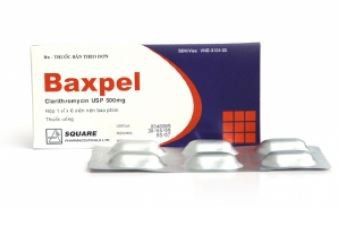This is an automatically translated article.
Cefamini is a semi-synthetic cephalosporin antibiotic used in the treatment of bacterial infections. So what should be noted when using Cefamini to achieve effectiveness and safety? Let's learn about Cefamini in this article.1. Uses of Cefamini
Cefamini is prepared in the form of powder for oral suspension with the active ingredient being Cephalexin with a strength of 250mg. Cephalexin has a bactericidal effect by inhibiting bacterial cell envelope synthesis. This is a 1st generation cephalosporin antibiotic and has the same antibacterial spectrum as other 1st generation cephalosporins.
2. Indications and contraindications of Cefamini
Cefamini is indicated in the case of infections caused by susceptible bacteria such as:
Respiratory infections (otitis media, sinusitis, pharyngitis) Infections of the skin, soft tissues, bones and joints Bacterial infections Genitourinary system, gonorrhea, syphilis Cefamini is contraindicated in patients with a history of allergy to cephalosporin antibiotics, a history of penicillin-induced anaphylaxis or other severe reactions mediated immunoglobulin IgE.
3. Dosage and how to use Cefamini
How to use:
Should take cephalexin on an empty stomach 1 hour before eating because food can reduce the rate of absorption of cephalexin.
For Cefamini powder for suspension: put the powder in a cup, add an appropriate amount of water and stir to form a suspension and drink immediately after mixing.
Dosage:
Children over 15 years old and adults: 250 - 500 mg/time every 6 hours depending on the degree of infection. The dose may be increased to 4 g/day in severe infections or with less susceptible organisms. Doses above 4g/day should be considered parenteral.
Tonsillitis and pharyngitis: 500 mg/time every 12 hours, taking the drug for at least 10 days. Bone and joint infections: 250 mg/time every 6 hours for mild to moderate infections. Higher doses are indicated in severe infections or infections with less susceptible organisms. Respiratory tract infections: 250 mg/times every 6 hours for mild to moderate infections. Higher doses are indicated in severe infections or infections with less susceptible organisms. Skin and skin structure infections: 500 mg/time every 12 hours. Urinary tract infections: For uncomplicated cystitis: 500 mg/time every 12 hours for 7-14 days. Children over 1 year old:
Dose: 25-100 mg/kg/day, divided into 3-4 times (maximum 4 g/day).
Acute otitis media: 75-100 mg/kg/day, divided into 4 times. Pharyngitis and tonsillitis (streptococcal pharyngitis): 25-50 mg/kg/day, divided into 2 doses 12 hours apart, for at least 10 days. Skin and skin structure infections: 25 - 50 mg/kg/day, divided into 2 divided doses 12 hours apart. Patients with renal impairment:
Patients with severe renal impairment: the safe dose may be lower than the usual dose.
Patients with creatinine clearance > 40 ml/min: no dose reduction required
Patients with creatinine clearance < 40 ml/min: first dose equal to usual dose, subsequent doses adjusted according to clearance creatinine clearance as shown in the table below:
| Độ thanh thải creatinine (ml/phút) | Liều dùng (mg) | Khoảng cách liều |
| 11 – 40 | 500 | Cách 8 - 12 giờ/lần |
| 5 -10 | 250 | Cách 12 giờ/lần |
| Dưới 5 | 250 | Cách 12 - 24 giờ /lần |
For patients on dialysis, the dose should be adjusted as follows:
Hemodialysis: add 1 dose normally used after dialysis.
Continuous peritoneal dialysis at home: The dose is adjusted as in patients with renal impairment.
4. Undesirable effects of Cefamini
The rate of desired reactions when using Cefamini is 3-6%.
Common undesirable effects (>1/100): diarrhea, nausea Uncommon side effects (1/1000 - 1/100): eosinophilia; rash, urticaria, itching; Reversible elevation of liver transaminases Rare adverse effects (<1/1000) include: Headache, dizziness, anaphylactic reactions, fatigue, Neutropenia, thrombocytopenia... Treatment of overdose:
Most patients only have nausea, vomiting, and diarrhea in acute overdose, however, neuromuscular hypersensitivity reactions and seizures may occur, especially in patients with CKD. When managing overdose, consideration should be given to the potential for multiple drug overdoses, drug interactions, and unusual patient pharmacokinetics.
No need for gastric lavage unless 5 to 10 times the usual dose of cephalexin has been taken. Hemodialysis is not necessary, although it helps to remove drugs from the blood.
It is important to protect the respiratory tract, ensure ventilation and hemodynamics for the patient. Give the patient multiple oral doses of activated charcoal as an alternative to or in addition to gastric lavage. When gastric lavage or activated charcoal is administered, the patient's airway should be protected.
5. Cefamine drug interactions
Concomitant use of high doses of cephalexin with nephrotoxic drugs (such as aminoglycosides) or potent diuretics (furosemide, etharynic acid and piretanide) may adversely affect renal function. However, at the recommended dose, there is no effect on the kidneys.There are few reports that cephalexin reduces the effect of oral contraceptives containing estrogen.
Cholestyramine slows intestinal absorption of cephalexin but this interaction is of little importance.
Probenecid increases the half-life of cephalexin and increases serum concentrations.
Cephalexin increases the effect of metformin
Cephalexin reduces the effect of typhoid vaccine.
Agents that cause uricuria may increase the effect of cephalexin.
6. Notes when using Cefamini
The long-term use of Cefamini, like other broad-spectrum antibiotics, may result in overgrowth of non-susceptible organisms (eg, Candida, Enterococcus, Clostridium difficile), in which cases the drug should be discontinued. . Cases of pseudomembranous colitis have been reported with broad-spectrum antibiotics, so during or after antibiotic use if severe diarrhea occurs, this diagnosis should be taken into account.
Generally, cephalexin is well tolerated even in penicillin-allergic patients, with rare cases of cross-allergic reactions.
Cefamini has no influence on the ability to drive and use machines.
In addition to the above important information about Cefamini, if you have any questions, patients should actively contact their doctor for examination and appropriate indications. Taking the correct dose of the drug is always more effective.
Please dial HOTLINE for more information or register for an appointment HERE. Download MyVinmec app to make appointments faster and to manage your bookings easily.













